Railway gun 21 cm SK Peter Adalbert (Germany)
The appearance of the 21 cm SK Peter Adalbert project was, rather, a necessary measure, since its main task was to use the existing guns that were suddenly left without a carrier. In January 1915, at the Battle of Dogger Bank, the German fleet lost the armored cruiser SMS Blücher. Together with the ship, several guns of the 21 cm SK L / 45 C / 06 type went to the bottom. In stock fleet there remained four spare guns, which were used only on the lost cruiser. The installation of guns on other ships of the fleet was impossible, because of which they decided to transfer them to ground forces. Through some modifications and the creation of additional equipment, the former sea guns could find application on land.
Shortly after the decision was made to transfer spare guns to the army, the Krupp concern received an order to create a railway conveyor compatible with decommissioned weapons. Other use of 210 mm guns was not possible. The wheel overhead carriage was too complicated, and there was no talk about installing a gun on a self-propelled chassis, because at that time there was simply no required technology. The only way to use guns was to create a super heavyweight artillery class system.
Soon the fleet suffered new losses. The death of several armored cruisers of the Prinz Adalbert and Roon classes led to the release of a certain number of 21 cm SK L / 40 C / 01 guns, which lay in the warehouses and waited for installation on ships during their repair and modernization. Thus, in a promising project, it was necessary to take into account the possibility of using tools of two types having the same caliber.
Like other projects of its class, the new railway cannon received a rather complicated name, nevertheless, completely revealing the essence of the whole development. The complex was called 21 cm Schnelladekanone auf Eisenbahn und Bettungsschiessgerüst - “210-mm gun for quick reloading on a railway platform with a gun platform.” In addition, the project was given the name Peter Adalbert. Apparently, like other similar projects, the project bore a working name in the form of a popular German name (Peter), to which was subsequently added the name of the Prussian Prince, borrowed from the name of the carrier ship of the gun.
The guns proposed for use, despite some differences, had certain similarities. They were very large and heavy, which made special demands on the transporter. For this reason, Krupp’s designers failed to use existing railroad cars. The transporter for the project “Peter Adalbert” had to be re-created, albeit using a large number of existing products and known solutions. The result was the emergence of a completely new design with a distinctive look.
For the correct distribution of the mass of the heavy artillery system on the railroad tracks, two large four-axle trucks had to be used. Trucks received their own housing, which was mounted on the fence, coupling device, etc. At the top of the trolley there was a king pin for mounting a gun platform.
It was proposed to mount all the main elements of the artillery complex on a special platform. This unit had a large size and was made of a significant number of individual metal parts connected with rivets. The front of the platform had a hinge for connecting to the front carriage. The central part had an increased height, its bottom was on the same level with the bodies of carts. The rear part of the platform was connected to the second carriage, but at the same time it was distinguished by a greater height of the bottom.
The large mass and impact of the proposed 210-mm guns led to the need to use the unloading system of carts. Behind the front carriage there were two lowered supports of a large area, which were to be lowered onto the embankment before firing. With the help of these supports it was proposed to supplement the existing wheels and increase contact with the tracks. The ability to shoot from the wheels without time-consuming and lengthy training was noted in the name of the complex with the word Eisenbahn.
An alternative to a full-fledged rail transporter capable of firing from the wheels was to be a simplified installation of the Bettungsschiessgerüst type. In the case of its application, it was necessary to dismantle a part of the railway tracks before firing, and then remove the wheel carts with a separate crane and install the platform on the ground. The full deployment of such a railway tool took at least three days. Preparation for the shooting of the towed system, leading the fire from the wheels, took much less time.
The front part of the implement platform did not have any special devices and was intended only for the correct placement of the gun while maintaining acceptable balancing. In the center of the platform, vertical supports with hinges were placed to install the rocking artillery unit. The rear compartment of the platform was given under the placement of the calculation and ammunition. For the safety of the gunners platform received a set of additional units. The front part had light fences. Near the breech of the gun and its supports there were large side platforms on which vertical armored sides were attached. Stern stowage and places of calculation covered with a large armored corps with a roof.
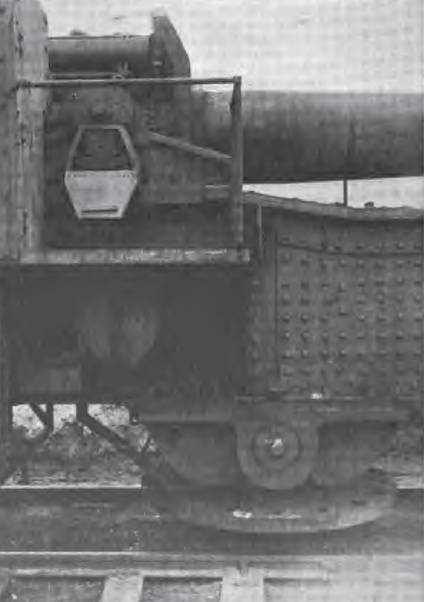
Cannon attachment systems and support platform
For mounting the gun in the central part of the platform, a U-shaped support was placed with the possibility of rotation around a vertical axis. The side elements of the support allowed for vertical guidance. The design of the gun mount and its drives made it possible to direct the gun within a sector of small width. Elevation angles varied from + 0 ° to + 45 °. Subsequently, the design of the gun support underwent some modifications, which allowed to increase the allowable sector of horizontal guidance. The support had attachments for mounting the shield cover.
At first, the 21 cm SK L / 45 C / 06 cannon was proposed for use in the Peter Adalbert artillery system. This gun had a rifled barrel with a caliber 210 mm 9,45 m long. Subsequently, a proposal appeared to use the 21 cm SK L / 40 C / 01 cannon, which was distinguished by some design features and a shorter barrel length. In this case, the barrel had a length of 8,4 m. Both guns were equipped with sliding wedge gates moving in a horizontal plane. Used recoil devices based on hydraulic recoil brakes and spring knuckles. These units were mounted above and below the barrel.
Armor-piercing and high-explosive shells were to be used with two guns. Both munitions had a mass of about 110 kg, but differed from each other in design and mass of explosive. A gun with a shorter barrel could disperse a projectile up to speed 770 m / s, with a long one - up to 790 m / s. The maximum range of shooting reached 26,4 km (21 cm SK L / 45 C / 06). In the case of the barrel length 40 calibers maximum range was approximately 900 m less.
The projectile was used together with a propelling charge placed in a metal sleeve. The increase in charge was made using a cap placed in the barrel immediately after the projectile. It was proposed to load the shot components into the chamber using a special hoist with manual drives located under the roof of the rear housing. The construction of the hoist provided additional rails, with which he could work both inside the case and beyond. In the latter case, it was possible to reload ammunition from any transport or from the ground.
The perspective large-caliber railway cannon turned out to be large and heavy. Regardless of the type of gun used, the length of the complex reached 15,85 m. The transverse dimensions met the requirements for railway transport. The mass of the installation with the 21 cm SK L / 40 C / 01 tool was 110,5 t, with the longer one - 104,7 t. At the same time, during serial production, for one reason or another, the dimensions and weight of the installation could vary within certain limits. Thus, a significant impact on such parameters has had the improvement of devices for placing the complex on the position.
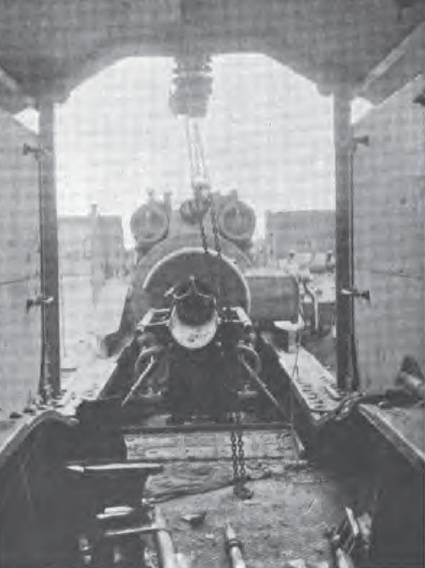
View of the breech cannon from the rear platform
In 1916, the Krupp concern built the first sample of the 21 cm SK SK Peter Adalbert system. According to some reports, this complex was built in the configuration Bettungsschiessgerüst - a gun platform transported by rail, requiring installation on the ground. Soon, several more such products were built with two available types of guns. The use of a gun platform with special features was the reason for criticism from the military department. The army was not satisfied with the need for the long-term deployment of the gun at the firing position, which completely leveled all the advantages of using rail transport.
Not later than 1917, the construction of Eisenbahn transporters began, requiring no special preparation or disassembly of the tracks. This technique quickly showed all its capabilities, after which it was decided to abandon the previous serial modification. From a certain time, all new models were built in the configuration of Eisenbahn und Bettungsschiessgerüst, which could fire both from the wheels and after installation on the ground. Subsequently, the weapons already existing in the military were modernized with the restructuring of the platforms in accordance with the new model.
The production of the tools "Peter Adalbert" started in 1916 year and lasted for about two years. During this time, 11 rail systems were manufactured in two versions. Later, all the complexes were rebuilt and brought in line with the project of a full-fledged conveyor that does not require a long deployment. In this form, the surviving guns survived until the end of the First World War.
The first railway implements, requiring long-term development, were handed over to the army at the very beginning of 1916, and soon went to war. The equipment was operated as part of batteries, each of which had one gun and a set of auxiliary equipment. February 21 1916 th gun of the new type made their first shots at real targets. The targets for the guns were enemy targets in the Verdun area. A few months later one of the guns participated in the Battle of the Somme. In 1917, Peter Adalbert’s calculations participated in the battles of Pashendale and Gallipoli. To participate in the spring offensive 1918, attracted seven gun batteries at once.
21 cm SK Peter Adalbert artillery systems performed well. The use of heavy shells in combination with a long-range shot allowed the enemy to inflict serious damage, destroying manpower and destroying various fortifications. A significant drawback was the long-term deployment of the guns of the first modification, but subsequently managed to get rid of this problem with corresponding consequences for the effectiveness of combat work.
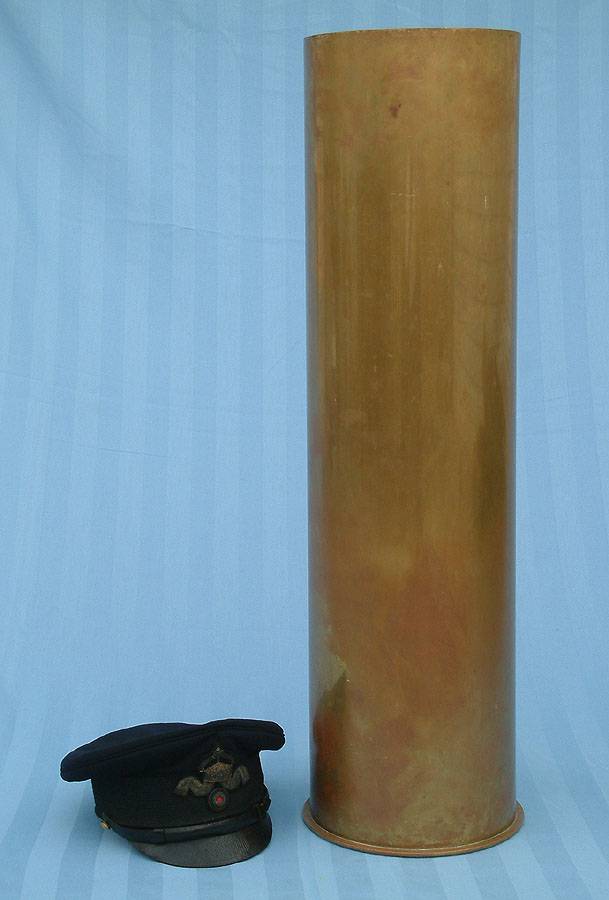
Sleeve 210-mm naval gun. Next to compare the cap of the German fleet
During the First World War, according to various sources, only a few guns "Peter Adalbert" were destroyed by enemy fire. In addition, some of the guns became trophies of the enemy. At the end of 1918, one gun went to French and American troops. At least six guns were still at the disposal of the German army.
The Versailles Peace Treaty imposed severe restrictions on the material part of the German armed forces. In particular, the development and operation of large and special power tools was prohibited. In accordance with the terms of the contract, Germany should soon get rid of all railway guns, including 21 cm SK Peter Adalbert. However, only two such systems were sent for recycling. Four more were sent to Swinemunde for use as part of a coastal defense battery. The command was able to find a loophole in the conditions of a peace treaty and use it, which made it possible to protect the guns from dismantling.
As far as is known, the operation of four 210-mm guns in the coastal batteries lasted for several years, but later they were written off in connection with the development of the resource. A few years later, the remaining "Peter Adalberta" also went for scrap. Thus, over the course of several years, all the 11 cannons built were destroyed by enemy fire or captured as a trophy, or decommissioned and melted down.
The 21 cm SK Peter Adalbert project was developed for one simple reason: Germany still has a certain amount of 210-mm naval guns that could not be installed on existing or under construction ships. Instead of disposing of waste products, it was decided to create a new type of railway installation. It was built only 11 samples of such technology, however, and this amount allowed to solve the main problem. In addition, new mobile weapons were useful in various combat operations. However, the entire 11 guns could not change the course of events and lead to a different end to the war.
On the materials of the sites:
http://kaisersbunker.com/
http://navweaps.com/
http://alternathistory.com/
http://forum.axishistory.com/
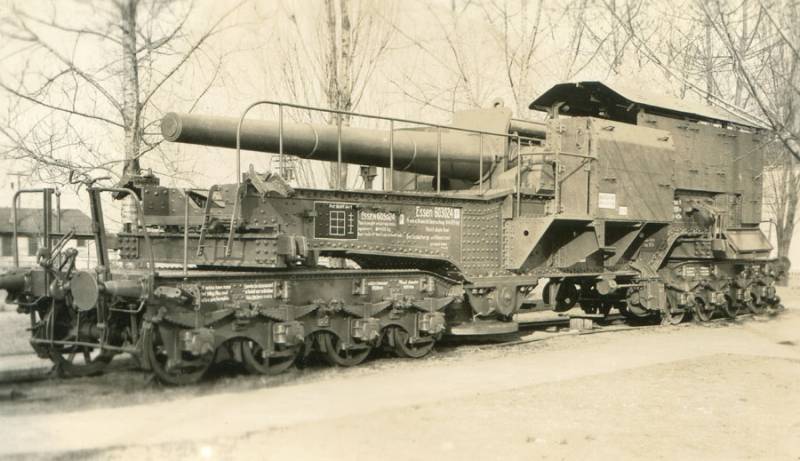
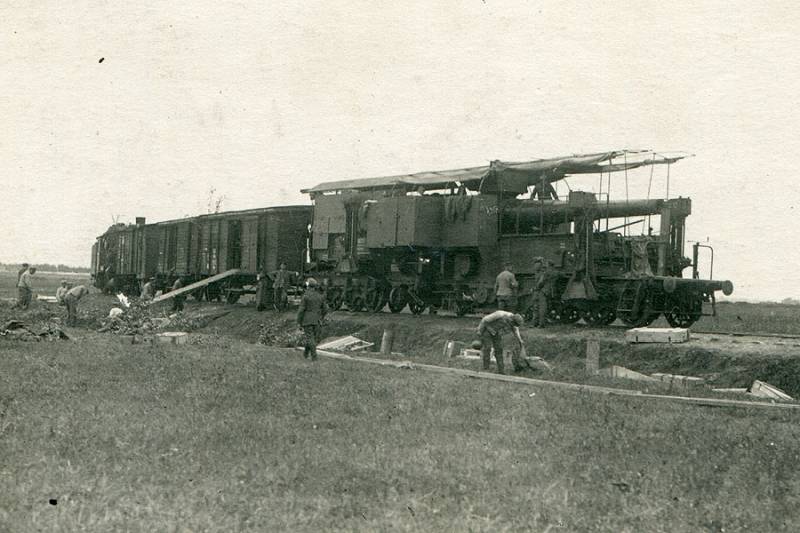
Information